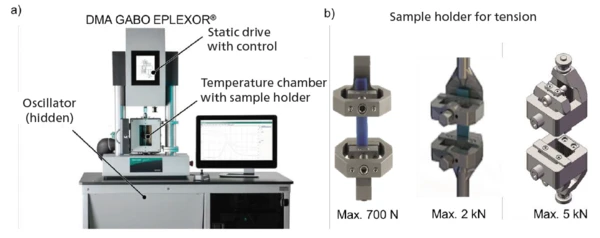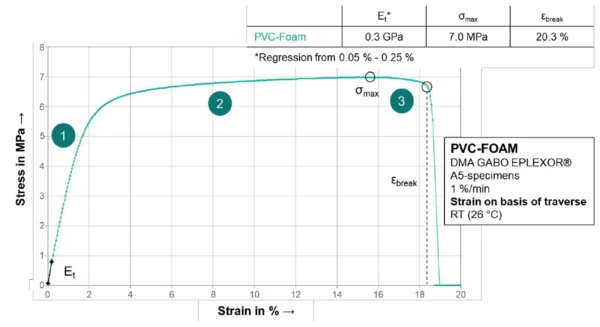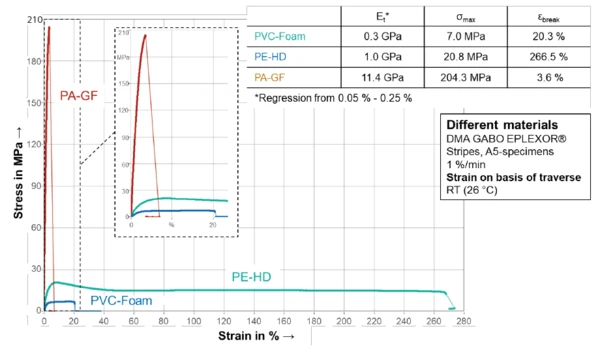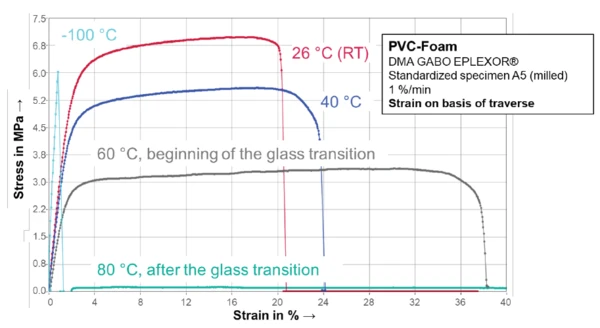Introduction
Quasi-static uniaxial tensile testing is a method of destructive materials testing and one of the most frequently employed methods for characterizing the mechanical properties of materials [1]. In the simplest case, a sample is subjected to load at a defined rate until failure occurs and the resulting force, F, is recorded as a function of length change, Δl. Based on the sample’s cross-section, A0, and the initial measuring length, l0, the StressStress is defined as a level of force applied on a sample with a well-defined cross section. (Stress = force/area). Samples having a circular or rectangular cross section can be compressed or stretched. Elastic materials like rubber can be stretched up to 5 to 10 times their original length.stress acting on the sample, σ, along with the resulting StrainStrain describes a deformation of a material, which is loaded mechanically by an external force or stress. Rubber compounds show creep properties, if a static load is applied.strain, ε, are calculated (figure 1, right).
The result of a tensile test is a so-called technical StressStress is defined as a level of force applied on a sample with a well-defined cross section. (Stress = force/area). Samples having a circular or rectangular cross section can be compressed or stretched. Elastic materials like rubber can be stretched up to 5 to 10 times their original length.stress-StrainStrain describes a deformation of a material, which is loaded mechanically by an external force or stress. Rubber compounds show creep properties, if a static load is applied.strain diagram (figure 1, left). Typical values derived from this are the tensile modulus or modulus of elasticity, Et, which describes the ratio of StressStress is defined as a level of force applied on a sample with a well-defined cross section. (Stress = force/area). Samples having a circular or rectangular cross section can be compressed or stretched. Elastic materials like rubber can be stretched up to 5 to 10 times their original length.stress and StrainStrain describes a deformation of a material, which is loaded mechanically by an external force or stress. Rubber compounds show creep properties, if a static load is applied.strain in the elastic range, the maximum StressStress is defined as a level of force applied on a sample with a well-defined cross section. (Stress = force/area). Samples having a circular or rectangular cross section can be compressed or stretched. Elastic materials like rubber can be stretched up to 5 to 10 times their original length.stress achievable by the material (σmax, εmax), and the StressStress is defined as a level of force applied on a sample with a well-defined cross section. (Stress = force/area). Samples having a circular or rectangular cross section can be compressed or stretched. Elastic materials like rubber can be stretched up to 5 to 10 times their original length.stress and StrainStrain describes a deformation of a material, which is loaded mechanically by an external force or stress. Rubber compounds show creep properties, if a static load is applied.strain values at fracture (σmax, εbreak) and at the transition from elastically reversible to plastic flow (σyield, εyield). Tensile testing further delivers information on lateral contraction, StrainStrain describes a deformation of a material, which is loaded mechanically by an external force or stress. Rubber compounds show creep properties, if a static load is applied.strain hardening, necking and ongoing failure behavior. Furthermore, by considering measurements in different orientations, it is also possible to characterize anisotropy, i.e., the dependence of the properties on direction. Testing is usually carried out in electromechanical tensile testers and is standardized according to the material, the semi-finished product and the application. Tensile testing is employed in almost all stages of a production chain, from material development and quality control in production to strength analysis on the final component.

The DMA GABO Eplexor® Series
Systems of the DMA GABO Eplexor® series are test instruments specially designed for dynamic-mechanical measurements (in short, DMA) in the high-load range. During a dynamic-mechanical test, a sinusoidal force is applied to a specimen under a defined temperature program. This results in a sinusoidal deformation. By analyzing the StressStress is defined as a level of force applied on a sample with a well-defined cross section. (Stress = force/area). Samples having a circular or rectangular cross section can be compressed or stretched. Elastic materials like rubber can be stretched up to 5 to 10 times their original length.stress and StrainStrain describes a deformation of a material, which is loaded mechanically by an external force or stress. Rubber compounds show creep properties, if a static load is applied.strain values along with the timely phase shift of the two, frequency- and temperature-dependent characterization of the visco-elastic properties such as storage and Viscous modulusThe complex modulus (viscous component), loss modulus, or G’’, is the “imaginary” part of the samples the overall complex modulus. This viscous component indicates the liquid like, or out of phase, response of the sample being measurement. loss modulus (E’ and E”) can be realized. Based on this, the Glass Transition TemperatureThe glass transition is one of the most important properties of amorphous and semi-crystalline materials, e.g., inorganic glasses, amorphous metals, polymers, pharmaceuticals and food ingredients, etc., and describes the temperature region where the mechanical properties of the materials change from hard and brittle to more soft, deformable or rubbery.glass transition of a polymer, for example, can be detected.
As shown in figure 2a), a static force can be applied to a sample in the DMA GABO Eplexor® by means of an upper drive. In the lower part of the instrument, an oscillation exciter generates a dynamic load with frequencies from 0.01 Hz to 100 Hz (optionally 0.0001 Hz and 200 Hz) as well as forces to 500 N and amplitudes to 6 mm. The temperature chamber allows for measurements from -160°C to 500°C, depending on the cooling system. The measurements can be carried out with the help of respective sample holders in shear, bending, tensile or compression mode.
However, due to the separately applicable static forces of up to 1.5 kN in the table-top unit (figure 2a), and up to 4.0 kN in the floor-standing device along with configurable measurement sequences, the DMA GABO Eplexor® systems are also suited for quasi-static tests such as uniaxial testing. The dynamic unit remains deactivated in this case. This way, materials can be characterized beyond their (visco-) elastic behavior up to the point of fracture. Depending on the material to be tested and the respective force requirements, mechanical tensile sample holders are available from max. 700 N to max. 5 kN (figure 2b).

The “Universal Testing” test program, predefined for quasi-static characterization, allows for tensile tests with defined StressStress is defined as a level of force applied on a sample with a well-defined cross section. (Stress = force/area). Samples having a circular or rectangular cross section can be compressed or stretched. Elastic materials like rubber can be stretched up to 5 to 10 times their original length.stress or StrainStrain describes a deformation of a material, which is loaded mechanically by an external force or stress. Rubber compounds show creep properties, if a static load is applied.strain increase control to be carried out in approximation to test standards like DIN EN ISO 6892-1 [2] or DIN EN ISO 527-1 [3]. In this case, it is an IsothermalTests at controlled and constant temperature are called isothermal.isothermal test mode in which a force or StrainStrain describes a deformation of a material, which is loaded mechanically by an external force or stress. Rubber compounds show creep properties, if a static load is applied.strain limit can be applied as a termination criterion. The maximum stroke of 60 mm is started at freely selectable rates of up to 150 mm/min, and recording of the sample’s StrainStrain describes a deformation of a material, which is loaded mechanically by an external force or stress. Rubber compounds show creep properties, if a static load is applied.strain is based on the traverse movement. In this context, it should be noted that – due to derivation of the sample’s strain based on the crosshead movement – the test can only be carried out in approixmation to test standards which prescribe a tactile or optical measuring system in this respect
Uniaxial Tensile Test in the DMA GABO Eplexor®
Figure 3 shows the technical StressStress is defined as a level of force applied on a sample with a well-defined cross section. (Stress = force/area). Samples having a circular or rectangular cross section can be compressed or stretched. Elastic materials like rubber can be stretched up to 5 to 10 times their original length.stress-strain diagram of a sheet material made of PVC foam along with derived characteristic values. The measurement was carried out at room temperature at a strain rate of 1 %/min. The sample corresponds to the 5A-geometry in accordance with DIN EN ISO 527-2 [4] with a width of 4.0 mm, a thickness of 2.8 mm and a parallel measurement length of 20.0 mm, which was first milled and then ground.
Depending on the material to be tested, strain rate and temperature, the shape of the technical strain-StressStress is defined as a level of force applied on a sample with a well-defined cross section. (Stress = force/area). Samples having a circular or rectangular cross section can be compressed or stretched. Elastic materials like rubber can be stretched up to 5 to 10 times their original length.stress diagram curve varies. In accordance with DIN EN ISO 527-1 [3], for example, it is possible to differentiate among four types. The resulting curve of the PVC foam material can be roughly divided into three areas. Firstly, there is the nearly linear range 1, which expands up to approx. 1.5% strain. In contrast to linear elastic metallic materials, plastics exhibit only a very limited linear range, which rapidly changes to nonlinear behavior already at low strain. In accordance with DIN EN ISO 527-1 [3], evaluation of the quasi-statically measured tensile modulus in the strain range from 0.05% to 0.25% is therefore stipulated by determining the relevant secant or by means of regression. In the case of the PVC foam investigated, the tensile modulus Et, calculated by regression, amounts to 0.3 GPa. Any deviations in storage modulus E‘ for a dynamic-mechanical measurement are due to the fact that dynamic-mechanical measurements are selectively carried out under a defined static load or resulting strain and differentiation is made between purely elastic (E‘) and viscous (E‘‘) components.
In the following section two, stretching of the porous foam material, initial micro damage and irreversible plastic deformation occur. The stress increases non-linearly with increasing strain. The maximum value reached by the material, σmax, is 7.0 MPa. In section 3, the sample continues to constrict and local material failure up to the point of fracture occurs. This is characterized by an elongation at break, εb, of 20.3%.

Measurement of Materials of Different Strength Classes
Thanks to the capability of exchanging the load cells of the Eplexor® instruments and also of scaling the sample dimensions, materials of different strength classes can be characterized as illustrated in figure 4. In addition to the PVC foam already shown, the results for a glass fiber-reinforced polyamide (PA-GF) with 30% fiber content and a high-DensityThe mass density is defined as the ratio between mass and volume. density polyethylene (PE-HD) are presented.
The filling of plastics is a typical procedure for improving mechanical properties, but it is also employed for adjustment of the electrical and Thermal ConductivityThermal conductivity (λ with the unit W/(m•K)) describes the transport of energy – in the form of heat – through a body of mass as the result of a temperature gradient (see fig. 1). According to the second law of thermodynamics, heat always flows in the direction of the lower temperature.thermal conductivity or modifying other properties. For example, the glass fiber-reinforced polyamide with a tensile strength of σmax of 204.3 MPa and an averaged tensile modulus, Et, of 11.4 GPa is many times stronger or stiffer than the PVC foam (σmax = 7 MPa and Et = 0.3 GPa) and polyethylene (σmax = 20.8 MPa and Et = 1.0 GPa). The course of the stress-strain curves is characterized by a quasi-linear increase in stress with almost immediate fracture at εb = 3.6%, which can be described as rather brittle behavior. Due to the glass fibers, which themselves exhibit high tensile strength (σmax > 2000 GPa) and stiffness (Et > 70 GPa) [5], the material is capable of withstanding high stresses. If the brittle fibers break, direct failure of the less strong polyamide matrix occurs.
Along with measuring comparatively tougher materials, materials with high elongation at break can also be investigated by adapting the parallel measuring length – if necessary, non-conform to standard. High-DensityThe mass density is defined as the ratio between mass and volume. density polyethylene (PE-HD) is a thermoplastic polymer produced from the monomer ethylene. Low branching of the polymer chains leads to higher DensityThe mass density is defined as the ratio between mass and volume. density of the material compared to conventional PE types [6]. Taking the maximum displacement of 60 mm into consideration, the measuring length was shortened to 10 mm for measuring the material. With εb = 266.5%, the material features a high elongation at break in relation to both the PVC foam and PA-GF. The course of the curve also differs significantly from that of the other polymer materials. Thus, after reaching the maximum stress, σmax = 20.8 MPa – at approx. 8% elongation – a comparatively long softening zone occurs up to the point of fracture.

Tensile Tests at Low and Elevated Temperature
In component design, the dependence of mechanical properties on temperature is essential for selecting a suitable material. Tensile tests at low and elevated temperatures provide information on how the material behaves at different operating environments. For example, it must be ensured that a structural component in an automobile can withstand the stresses of its application both at low temperatures in winter and at high temperatures in summer without failure. Along with the establishment of a relevant application window, those tests also yield important information for processing – for example, the temperature range in which a sheet material becomes soft and can best be hot-formed. In this case, the data serve for the generation of a processing window.
All instruments of the DMA GABO Eplexor® series can be equipped with a temperature chamber and allow – depending on the cooling system – for measurements from -160°C to 500°C. Customers who typically carry out dynamic-mechanical characterizations with a DMA GABO Eplexor® also thereby have the ability to characterize their materials with the help of temperature-dependent tensile tests and can thus learn far more about their materials than through classical DMA measurements.
Figure 5 shows the temperature-dependent material behavior of a PVC foam in tensile tests. As can be seen, the temperature significantly influences both the mechanical properties and the characteristics of the stress-strain curve. At low temperatures of -100°C, the material exhibits brittle fracture behavior. The sample behaves in an almost linear elastic fashion and breaks directly at strains below 1% after reaching a stress of approximately 6 MPa. By increasing the temperature to 26°C, which corresponds to room temperature, the slope in the linear elastic range decreases and so does the tensile modulus. Furthermore, a distinct non-linear plastic range with subsequent fracture becomes apparent. A further increase in temperature to 40°C results in a decrease in tensile modulus (not explicitly shown here) and a reduction of the maximum attainable stress. The elongation at break increases slightly. In the initial range of the Glass Transition TemperatureThe glass transition is one of the most important properties of amorphous and semi-crystalline materials, e.g., inorganic glasses, amorphous metals, polymers, pharmaceuticals and food ingredients, etc., and describes the temperature region where the mechanical properties of the materials change from hard and brittle to more soft, deformable or rubbery.glass transition at 60°C (onset temperature of E‘ from the DMA measurement: 61.3°C), the elongation at break nearly doubles (εb = 37%) and the strength (σmax = 3.5 MPa) is halved in comparison with room temperature (εb = 20.3%; σmax = 7.0 MPa).

At 80°C – after the Glass Transition TemperatureThe glass transition is one of the most important properties of amorphous and semi-crystalline materials, e.g., inorganic glasses, amorphous metals, polymers, pharmaceuticals and food ingredients, etc., and describes the temperature region where the mechanical properties of the materials change from hard and brittle to more soft, deformable or rubbery.glass transition – the material is in the so-called entropy-elastic state. The polymer chains can now move freely against each other and the material becomes soft. In tensile testing, the stresses are reduced to a level below 0.3 MPa and the material can be stretched – within the framework of the measurement conditions – without the occurrence of fracture.
Summary
DMA GABO Eplexor® instruments are specially designed for the measurement of dynamic-mechanical properties. Thanks to the capability of applying static forces of up to 4 kN as well as the high flexibility in program definition, they can also be employed as devices for quasi-static tensile testing. This enables the user to characterize his materials far beyond the linear visco-elastic range. Starting with analyses of hardening and softening characteristics, information on the necking and fracture behavior can be obtained. An important functionality of the DMA GABO Eplexor® in this context is its highly precise temperature control regulated by means of the temperature chamber. The user can determine how materials behave under high load both in the low-temperature range beginning at -160°C and at temperatures up to 500°C, thus obtaining important information on material comparisons, processing procedures and the later use of the component.